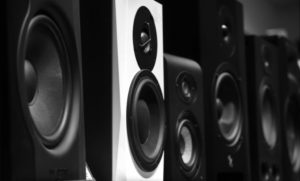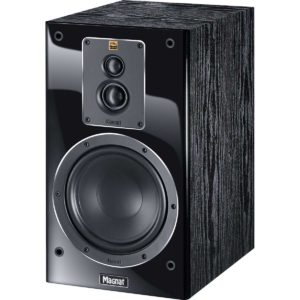 If you're a music lover or an audiophile, chances are you've been down the rabbit hole of speaker systems. There's a galaxy of options out there, but two types stand out in particular: 2-way and 3-way speakers.
If you're a music lover or an audiophile, chances are you've been down the rabbit hole of speaker systems. There's a galaxy of options out there, but two types stand out in particular: 2-way and 3-way speakers.
This article will explore the differences between these two categories, shedding light on what makes them unique and how they impact the sound quality of your music.
The Basics: Defining 2-Way and 3-Way Speakers
 Let's first understand what we mean by "2-way vs 3-way speakers." These terms reference the number of drivers, or components, that produce sound in the speaker system.
Let's first understand what we mean by "2-way vs 3-way speakers." These terms reference the number of drivers, or components, that produce sound in the speaker system.
In a 2-way speaker, there are two drivers: a woofer to handle the low frequencies and a tweeter for the high frequencies. On the other hand, a three-way speaker system comes equipped with three drivers: a woofer, a mid-range, and a tweeter, responsible for low, mid-range, and high frequencies respectively.
2-Way Speakers: The Simple Solution
2-way speakers are typically more affordable and easier to install, making them an attractive option for individuals on a budget or those taking their first foray into the world of car speakers. Music with less bass output or those who prefer the basic balance of sound may find 2-way speakers to be perfectly satisfactory.
Let's say you've just installed a set of 2-way speakers in your car. As you hit the road and turn up the volume, you’ll notice the speaker sound is clear but perhaps not as comprehensive in terms of frequency as you might prefer. The lows and the highs are there, but you might feel the lack of a dedicated driver for the mid-frequencies.
3-Way Speakers: For the Audiophile in You
For those seeking a more precise and immersive listening experience, the 3-way speakers could be a better option. The inclusion of the midrange driver means this full-range speaker offers a broader frequency response, lower distortion, and an overall more balanced sound.
For instance, if you are listening to an orchestral piece through 3-way speakers, you might notice the refined clarity of the violins (high-frequency sounds), the lush resonance of the cellos (mid-range frequencies), and the deep rumble of the double bass (low frequencies). This distinct representation of each instrument is because of the three drivers dedicated to their respective frequency ranges.
3-way speakers are often larger and somewhat more expensive than their 2-way counterparts. They require more finesse to install, especially when upgrading your car's sound system. But, for those craving exceptional sound, the investment in time and money can be well worth it.
Weighing the Pros and Cons: A Closer Look at 2-Way and 3-Way Speaker Systems
Every choice comes with its own set of advantages and drawbacks. The same goes for choosing between a 2-way or 3-way speaker. To ensure that you're making the best decision for your audio needs, it's crucial to understand the pros and cons of each option.
The 2-Way Speaker System: Pros and Cons
Advantages:
Affordability: Cost is a crucial factor when investing in audio equipment. In general, 2-way speakers tend to be more affordable than their 3-way counterparts, making them a popular choice for budget-conscious music lovers.
Simplicity: With just a woofer and a tweeter, 2-way speakers are less complex than 3-way speakers. This simplicity makes them easier to install and maintain. Whether you want to upgrade your car sound system or set up a home stereo, 2-way speakers offer a more straightforward solution.
Versatility: Thanks to their simpler design, 2-way speakers are typically smaller and more compact. This makes them suitable for a wider variety of spaces, including smaller rooms and cars.
Disadvantages:
Limited Frequency Range: The main drawback of 2-way speakers is their lack of a dedicated midrange driver. This means that they can't handle mid frequencies as accurately as 3-way speakers, which could result in a less detailed sound.
Sound Quality: While 2-way speakers cover the basic low and high frequencies well, the absence of a midrange driver may cause the sound to be less balanced and immersive.
The 3-Way Speaker System: Pros and Cons
Advantages:
Greater Frequency Range: The primary advantage of a 3-way speaker is its broader frequency range. With a dedicated driver for low, mid-range, and high frequencies, 3-way speakers deliver a more comprehensive and balanced sound.
Detailed Sound: 3-way speakers can deliver superior sound quality, especially for complex pieces of music that span a wide range of frequencies.
Audiophile Favorite: For audiophiles and music enthusiasts, 3-way speakers are often the preferred choice. The detailed and nuanced sound they produce can significantly enhance the listening experience, making them worth the higher price tag for many.
Disadvantages:
Cost: With greater complexity and sound comes a higher price tag. 3-way speakers are generally more expensive than 2-way speakers, which might make them less accessible for some.
Size: Given the additional driver, 3-way speakers tend to be larger than 2-way speakers. This can make them unsuitable for smaller spaces and more challenging to install in certain settings, such as compact car interiors.
Complexity: The superior sound of 3-way speakers comes at the cost of increased complexity, which could make installation and maintenance more challenging for beginners.
Ultimately, the choice between 2-way vs. 3-way speakers depends on your preferences, space, and budget. Remember to weigh the pros and cons carefully to decide what best suits your audio needs.
2-Way and 3-Way Speakers: Finding the Perfect Match for Your Favorite Music Genre

Often overlooked in the 2-way vs 3-way speaker debate is the critical influence of music genre. Different genres emphasize different sound frequencies, so they can sound distinctly better on one type of speaker system over the other.
Let's delve into some popular music genres and which speaker system might best serve their unique characteristics.
Pop and Rock Music
Pop and rock music often emphasize both the low and high ends of the frequency spectrum, thanks to the heavy use of drums and electric guitars. These genres can be adequately served by 2-way speakers, which effectively cover these low and high frequencies. If you're mostly a fan of these genres, a 2-way speaker system might be a smart, economical choice.
Classical Music
Classical music, with its array of instruments and wide range of frequencies, can truly shine on a 3-way speaker system. The intricate interplay of high-frequency sounds from the violins, mid-range frequencies from the violas, and the low frequencies from cellos and basses are best represented by 3-way speakers, which have dedicated drivers for each of these frequency ranges.
Jazz and Vocal-Centric Music
Jazz and vocal-centric music often rely heavily on mid-range frequencies, courtesy of brass instruments, pianos, and of course, human voices. A 3-way speaker system can reproduce these frequencies with superior precision, making it an excellent choice for jazz enthusiasts or those who enjoy music where vocals take center stage.
The bottom line? Your preferred music genre should definitely be a factor when choosing between a 2-way and 3-way speaker system. While 2-way speakers can provide a satisfying listening experience for genres that emphasize the high and low ends of the frequency spectrum, 3-way speakers are likely a better choice for genres that cover a broader range of frequencies.
As always, personal preference reigns supreme, but considering your favorite music genres in your decision will surely enhance your overall listening experience.
Making a choice: 2-Way or 3-Way?

In the debate of "2-way vs. 3-way speakers," it's essential to remember that neither is inherently superior. Each caters to different audio preferences and budget constraints. A two-way speaker system is fantastic for casual listeners and those who enjoy music with less bass. On the other hand, a 3-way speaker system is the go-to for individuals seeking a fuller and more intricate sound.
Your choice should be guided by your personal preferences. Are you after a simple, clear sound? Or do you desire an immersive audio experience with well-defined high, mid-range, and low frequencies?
Perhaps you're looking for speakers to boost your car's audio capabilities. In that case, you might want to consider 6.5 speakers or speakers that offer great bass. Purchasing two speakers or more will help you create a surround sound system.
Conclusion
In conclusion, whether you choose a 2-way or 3-way speaker system, understanding the differences will ensure that you make the right choice for your audio needs. Always remember, the best speakers are the ones that sound best to you. Happy listening!
